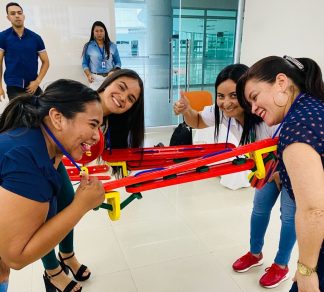Building Lego and MTa into your learning experience
Lego Serious Play and MTa’s experiential learning kits are excellent partners in creating engaging learning and development activities. But to get the most from them, you really need to understand how they can work together.
We already looked at how MTa is an alternative to LSP when you want to focus more on behaviours in this article. In this post we explore how they can be used together.
LSP gives people a way of expressing their ideas, sharing perspectives and creating action plans. It lets you literally build a model of how people feel the team is performing or how they would like it to be performing. But MTa shows you how the team IS performing and allows you to explore what happens if you make changes.
Where are we going, and what will it look like?
“LSP is all about the what”, says Roberto Ezkenazi, director of training consultancy Hard Fun – El Poder del Juego, in Santiago, Chile. “It’s about planning, presenting a current situation and then imagining a future one.
“You can use it to answer the question: what should our team look like??”
But chances are, if you asked your team of four or five individuals to each build a model of the current team, you’d get four or five slightly different results. And if you asked them to build the optimal model for a future programme, you’d get more widely varying results.
And what happens next will very much depend on the people in the team. Do you have a team where people want to reach consensus, or will dominant individuals steadfastly stick to their own ideas and shout everyone else down? Who ultimately gets to decide what the best vision of the future looks like. How do you get everyone on board when they all had their own quite different ideas?
So, you can use LSP as a tool to help everyone share ideas and create a vision, for which there is genuine consensus. You then need to explore what’s going to happen when people work together.
How do we do it
MTa experiential learning kits help you look at how the team is actually performing. What really happens when individuals with different perspectives attempt to ‘live’ their vision?
Here, you’re exploring behaviours, and emotions ultimately drive behaviour.
“If LSP is all about the “what” then MTa is all about the “how,” says Hard Fun’s Ezkenazi. He explains that MTa’s kits help you to see what really happens when you try to deploy a vision for real: you get to see how people interact
This is where the critical difference between MTa and LSP becomes apparent. All of MTa’s activities demand individuals to work together as a team: there is a large degree of interdependence between team members and success demands a high level of cooperation.
So, the rich dynamics created by the MTa activities provide the perfect proving and testing ground for the output of the LSP session.
Putting the pieces together
There is a natural fit between LSP and MTa. LSP lets show the world what you want to do but MTa lets you go and and do it so you can figure out the best way to make it work. Put them both together, and you have opportunities for some very rich learning.
Mat East, Managing Director at Sparks International in Dubai has used LSP and MTa kits as part of the same programme to do different things
“We had a three-day workshop for a client in Abu Dhabi. We used LSP on the first day and then MTa on day two. With LSP it was about getting people to articulate their opinions, and then we used MTa for developing crucial behavioural skills, that would enable them to be successful, like analytical thinking and problem-solving
Hard Fun’s Roberto Ezkenazi has also used LSP and MTa successfully as part of the same programme.
“I use LSP to get the actual view of participants about the company and then build the model that shows the gap between the current and desired situation,” he explains.
“Then we come to the ‘how’. What soft skills do we need to get to that future state? I’d pull up a flip chart and write these down, for example, communications, empathy etc. And then I’d find the right MTa activity to build those skills and we’d focus on those the following day.”
With MTa, most of the learning comes from post-activity reflection: people reflect on how the team performed, how they behaved in certain situations and what they could have done differently, and better.
Using LSP and MTA together allows your learners to both communicate and experience the situations they need to share.
Here’s an example of how you can use both together when setting up a new project team.
Building the new team
- Innovation: Use Lego Serious Play: everyone builds a model of their vision for the new team
- Building Consensus and Generating Buy in: Discuss the different models and reach consensus about the team vision
- Testing the Vision: Use an activity from MTa Team Kit to apply the vision in practice.
- Review Performance: Use the MTa review process to reflect on the team performance. How did it go?
- Final test: Use a second MTa Team activity to apply any learning and refine the vision
- Apply the new team vision in the workplace
By Jamie Thompson, Managing Director of MTa Learning
MTa are experts in the field of experiential learning since 1982. We provide kits of experiential learning activities which are carefully designed. Our activities are fun, engaging and memorable – but effective too.
We also deliver MTa Facilitator Masterclasses for those Learning & Development professionals who want to ensure they capitalize on their investment in experiential learning.
Leading organisations around the world trust MTa with their Learning and Development requirements. If you’d like to find out more, please get in touch.

